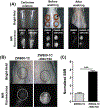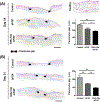Enhancement of Wound Healing Efficacy by Increasing the Stability and Skin-Penetrating Property of bFGF Using 30Kc19α-Based Fusion Protein
- PMID: 33724733
- PMCID: PMC7996635
- DOI: 10.1002/adbi.202000176
Enhancement of Wound Healing Efficacy by Increasing the Stability and Skin-Penetrating Property of bFGF Using 30Kc19α-Based Fusion Protein
Abstract
The instability of recombinant basic fibroblast growth factor (bFGF) is a major disadvantage for its therapeutic use and means frequent applications to cells or tissues are required for sustained effects. Originating from silkworm hemolymph, 30Kc19α is a cell-penetrating protein that also has protein stabilization properties. Herein, it is investigated whether fusing 30Kc19α to bFGF can enhance the stability and skin penetration properties of bFGF, which may consequently increase its therapeutic efficacy. The fusion of 30Kc19α to bFGF protein increases protein stability, as confirmed by ELISA. 30Kc19α-bFGF also retains the biological activity of bFGF as it facilitates the migration and proliferation of fibroblasts and angiogenesis of endothelial cells. It is discovered that 30Kc19α can improve the transdermal delivery of a small molecular fluorophore through the skin of hairless mice. Importantly, it increases the accumulation of bFGF and further facilitates its translocation into the skin through follicular routes. Finally, when applied to a skin wound model in vivo, 30Kc19α-bFGF penetrates the dermis layer effectively, which promotes cell proliferation, tissue granulation, angiogenesis, and tissue remodeling. Consequently, the findings suggest that 30Kc19α improves the therapeutic functionalities of bFGF, and would be useful as a protein stabilizer and/or a delivery vehicle in therapeutic applications.
Keywords: basic fibroblast growth factor; cell-penetrating proteins; protein stabilizer; skin wound healing; transdermal delivery.
© 2021 Wiley-VCH GmbH.
Conflict of interest statement
Conflict of interest
The authors have declared that no competing interest exists.
Figures









Similar articles
-
Secured delivery of basic fibroblast growth factor using human serum albumin-based protein nanoparticles for enhanced wound healing and regeneration.J Nanobiotechnology. 2023 Sep 2;21(1):310. doi: 10.1186/s12951-023-02053-4. J Nanobiotechnology. 2023. PMID: 37658367 Free PMC article.
-
The efficacy of basic fibroblast growth factor-loaded poly(lactic-co-glycolic acid) nanosheet for mouse wound healing.Wound Repair Regen. 2017 Nov;25(6):1008-1016. doi: 10.1111/wrr.12604. Epub 2018 Feb 9. Wound Repair Regen. 2017. PMID: 29315978
-
Effect of chitosan film containing basic fibroblast growth factor on wound healing in genetically diabetic mice.J Biomed Mater Res A. 2003 Jan 1;64(1):177-81. doi: 10.1002/jbm.a.10396. J Biomed Mater Res A. 2003. PMID: 12483711
-
Enhancement of anti-tumor activity in melanoma using arginine deiminase fused with 30Kc19α protein.Appl Microbiol Biotechnol. 2022 Nov;106(22):7531-7545. doi: 10.1007/s00253-022-12218-0. Epub 2022 Oct 13. Appl Microbiol Biotechnol. 2022. PMID: 36227339
-
Basic Fibroblast Growth Factor in Scarless Wound Healing.Adv Wound Care (New Rochelle). 2013 Mar;2(2):44-49. doi: 10.1089/wound.2011.0324. Adv Wound Care (New Rochelle). 2013. PMID: 24527324 Free PMC article. Review.
Cited by
-
Bone-Targeted Delivery of Cell-Penetrating-RUNX2 Fusion Protein in Osteoporosis Model.Adv Sci (Weinh). 2023 Oct;10(28):e2301570. doi: 10.1002/advs.202301570. Epub 2023 Aug 13. Adv Sci (Weinh). 2023. PMID: 37574255 Free PMC article.
-
Injective hydrogel encapsulating dental pulp stem cells for the treatment of traumatic optic nerve injury.Front Bioeng Biotechnol. 2025 Feb 25;13:1528749. doi: 10.3389/fbioe.2025.1528749. eCollection 2025. Front Bioeng Biotechnol. 2025. PMID: 40070549 Free PMC article.
-
Improved Neural Inductivity of Size-Controlled 3D Human Embryonic Stem Cells Using Magnetic Nanoparticles.Biomater Res. 2024 Mar 15;28:0011. doi: 10.34133/bmr.0011. eCollection 2024. Biomater Res. 2024. PMID: 38500782 Free PMC article.
-
MicroRNA-155 mediates multiple gene regulations pertinent to the role of human adipose-derived mesenchymal stem cells in skin regeneration.Front Bioeng Biotechnol. 2024 Mar 18;12:1328504. doi: 10.3389/fbioe.2024.1328504. eCollection 2024. Front Bioeng Biotechnol. 2024. PMID: 38562669 Free PMC article.
-
Growth Factor and Cytokine Delivery Systems for Wound Healing.Cold Spring Harb Perspect Biol. 2022 Aug 1;14(8):a041234. doi: 10.1101/cshperspect.a041234. Cold Spring Harb Perspect Biol. 2022. PMID: 35667794 Free PMC article. Review.
References
-
- Kanazawa S, Fujiwara T, Matsuzaki S, Shingaki K, Taniguchi M, Miyata S, Tohyama M, Sakai Y, Yano K, Hosokawa K, PLoS One 2010, 5, e12228; - PMC - PubMed
- Song YH, Zhu YT, Ding J, Zhou FY, Xue JX, Jung JH, Li ZJ, Gao WY, Mol. Med. Rep 2016, 14, 3336; - PubMed
- O’keefe EJ, Chiu ML, Payne RE Jr, J. Investig. Dermatol 1988, 90; - PubMed
- Sogabe Y, Abe M, Yokoyama Y, Ishikawa O, Wound Repair Regen. 2006, 14, 457; - PubMed
- Przybylski M, J. Wound Care 2009, 18, 516. - PubMed
-
- Uchi H, Igarashi A, Urabe K, Koga T, Nakayama J, Kawamori R, Tamaki K, Hirakata H, Ohura T, Furue M, Eur. J. Dermatol 2009, 19, 461; - PubMed
- Nunes QM, Li Y, Sun C, Kinnunen TK, Fernig DG, PeerJ 2016, 4, e1535; - PMC - PubMed
- Akita S, Akino K, Imaizumi T, Hirano A, Wound Repair Regen. 2008, 16, 635. - PubMed
Publication types
MeSH terms
Substances
Grants and funding
LinkOut - more resources
Full Text Sources
Other Literature Sources

